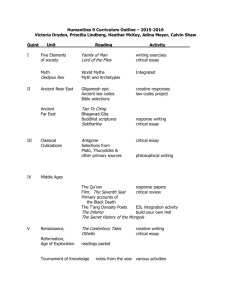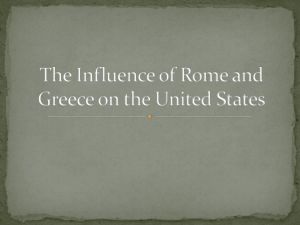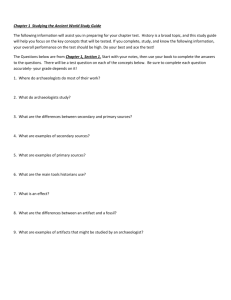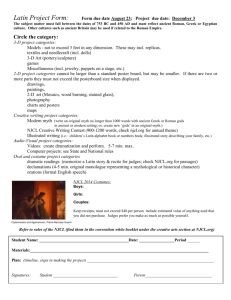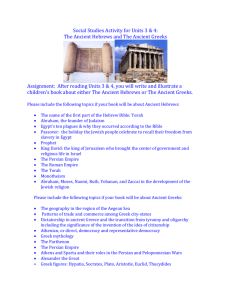Classical Civilizations DBQ
advertisement
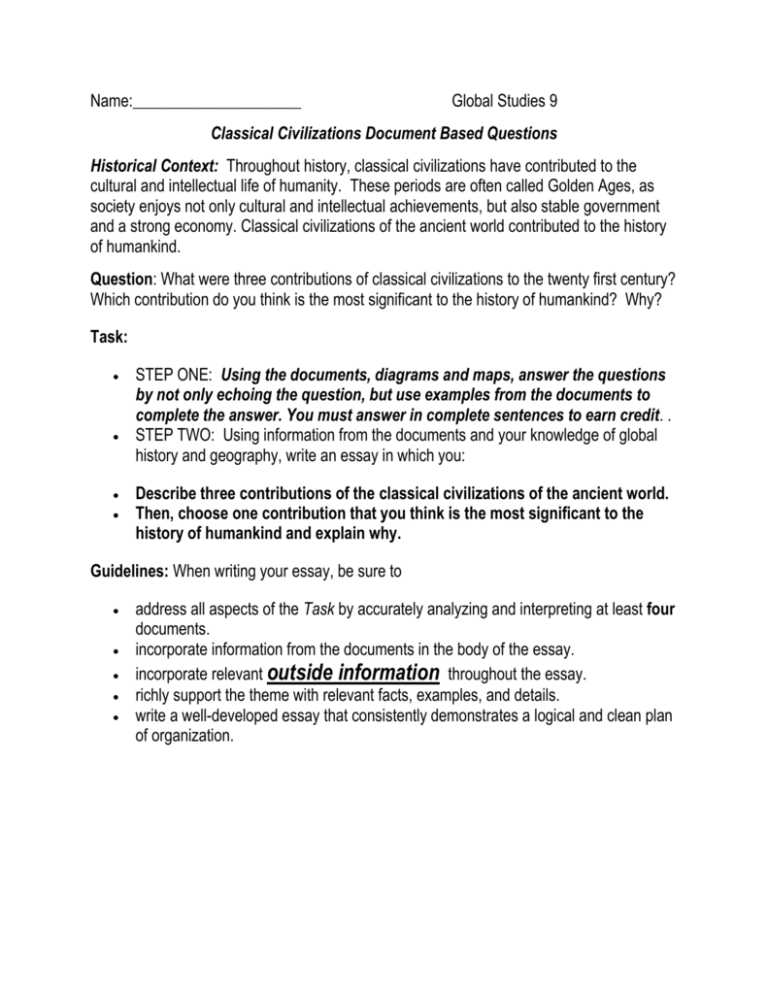
Name:_____________________ Global Studies 9 Classical Civilizations Document Based Questions Historical Context: Throughout history, classical civilizations have contributed to the cultural and intellectual life of humanity. These periods are often called Golden Ages, as society enjoys not only cultural and intellectual achievements, but also stable government and a strong economy. Classical civilizations of the ancient world contributed to the history of humankind. Question: What were three contributions of classical civilizations to the twenty first century? Which contribution do you think is the most significant to the history of humankind? Why? Task: STEP ONE: Using the documents, diagrams and maps, answer the questions by not only echoing the question, but use examples from the documents to complete the answer. You must answer in complete sentences to earn credit. . STEP TWO: Using information from the documents and your knowledge of global history and geography, write an essay in which you: Describe three contributions of the classical civilizations of the ancient world. Then, choose one contribution that you think is the most significant to the history of humankind and explain why. Guidelines: When writing your essay, be sure to address all aspects of the Task by accurately analyzing and interpreting at least four documents. incorporate information from the documents in the body of the essay. incorporate relevant outside information throughout the essay. richly support the theme with relevant facts, examples, and details. write a well-developed essay that consistently demonstrates a logical and clean plan of organization. Document One: The business of trade provided the Ancient Culture to interact with people of Central Asia. The new foods such as grapes, walnuts, and garlic provided the people with a reason to trade. The exchange of goods gave rise to a major new trade route known as the Silk Road. The route ran from China to the Mediterranean Sea. It was not a single route, but a series of routes which covered more than 4,000 miles, which the equivalent of a road from Chicago to Hawaii! The road was very dangerous because of thieves and the environment. The road passed through mountains as well as deserts. To travel would be prosperous, but it was also very treacherous. The name “Silk Road” comes from the major good silk which was desired throughout Europe and Asia. China traded the silk which came from worms, for goods that ranged from jewels, horses, and linens. Along with the goods, ideas traveled to China. Buddhism and was brought to China based upon the trade with India. Trade was an important influence on the development of the Ancient Chinese culture. This excerpt is a description of Hangzhou, a southern city that was part of the Chinese empire and a stopping spot on the Silk Road. “There are within the city ten principal squares or market places, besides innumerable shops along the streets. .... On the nearer bank ... stand large stone warehouses provided for merchants who arrive from India and other parts with their goods and effects. They are thus situated conveniently close to the market squares. In each of these, three days in every week, from forty to fifty thousand persons come to these markets and supply them with every article that could be desired.” 1.) Where did the trade route get the name “Silk Road” from? _______________________________________________________ _______________________________________________________ _______________________________________________________ 2.) What were some problems facing traders following the Silk Road? _______________________________________________________ _______________________________________________________ _______________________________________________________ 3.) How did trade help Ancient China to develop? _______________________________________________________ _______________________________________________________ _______________________________________________________ 4.) How did the Silk Road promote cultural diffusion? _______________________________________________________ _______________________________________________________ _______________________________________________________ Document #2 Ancient China was able to stabilize their government and focus on the science and technology development. It was here where China has influenced modern times in a variety of ways. Farming, medicine, education, and travel were all directly influenced by Ancient China. There are numerous advances that we have today which are connected to the frequent inventions and scientific developments from Ancient China. Focusing on technology makes work more efficient, advances medicine, and improves education. All of these advances are the foundation of developing a successful society. Technology Paper from wood pulp Iron plow for breaking soil Rudder- device to steer ships Wheelbarrow Fishing reel Compass Medicine Acupuncture: treatment of disease using needles Anesthetics- substance that puts patients to sleep during surgery Herbal remedies discovery of plants useful as medicines The Arts Silk Weaving Jade carving Bronze metallurgy Temples and palaces Poetry and history Philosophy Confucianism Daoism 1.) What would be a good title for the graphic above? Why? ___________________________________________________________________ ___________________________________________________________________ ___________________________________________________________________ 2.) How was China able to invent and develop so many things? ___________________________________________________________________ ___________________________________________________________________ ___________________________________________________________________ ___________________________________________________________________ 3.) Choose two examples from the graphic organizer and explain how they are used today. ___________________________________________________________________ ___________________________________________________________________ ___________________________________________________________________ ___________________________________________________________________ Document #3 "Whoever honors his own [religion] and insults another man's whether from blind loyalty or with the intention of showing his own [religion] in a favorable light, does his own [religion] the greatest possible harm. Acceptance is best, with each hearing and respecting the other's teachings. It is the wish of the [king] that members of all religions should learn from one another and should teach virtue." —From the Edicts of Asoka (268 B.C.) 1. What did the Mauryan ruler, Asoka, say about religious tolerance? ___________________________________________________________________ ___________________________________________________________________ ___________________________________________________________________ ___________________________________________________________________ 2. What were the effects of Asoka’s edicts throughout Asia? ___________________________________________________________________ ___________________________________________________________________ ___________________________________________________________________ ___________________________________________________________________ Document #4 Empires of Ancient India Maurya Gupta Dates 321 B.C.–185 B.C. A.D. 320–550 Location Northern and southern India Northern India Government Learning 1. Harsh rule Organized government Officials collect taxes Governmentowned factories Schools and libraries in capital Missionaries spread Buddhism Mild rule Organized government Villages and cities had power Golden age of learning Number system we use today, decimal system Plastic surgery, vaccines for smallpox Carvings of gods and animals What contributions were made in math and science during the Gupta Empire? _________________________________________________________________________ _________________________________________________________________________ _________________________________________________________________________ _________________________________________________________________________ _________________________________________________________________________ Document Five: In the ancient Greek city-state of Athens, citizenship carried both rights and responsibilities. A male citizen was expected to help defend Athens in war, to serve on a jury, and to participate in debates about issues. Pericles, a great leader in Athens, said: “We do not say that a man who takes no interest in politics is a man who minds his own business; we say that he has no business here at all.” 1. What did Pericles think about citizens who did not participate in politics? What words lead you to think this? ______________________________________________________________________________ ______________________________________________________________________________ ______________________________________________________________________________ ______________________________________________________________________________ Document Six: There is a saying that “All roads lead to Rome”. This was definitely true. The Romans built about 50,000 miles of roads across the empire. The roads were used to link far-away provinces with Rome. The army used them to move soldiers quickly from area to area. Traders used roads to sell goods and food throughout the empire. Diagram of Roman Road Map of Roman Road Network 1. How would Roman Roads strengthen the empire? _________________________________________________________________________________ _________________________________________________________________________________ _________________________________________________________________________________ Document Seven: The ancient Roman Empire covered a huge area and included many groups of people. To rule such a large area, the Romans created a code of laws, the 12 tables. Many nations still use the principles of the 12 table to create their laws today. What follows are some principles, or basic rules, that the Romans developed. All free people have equal rights before the law. A person must be considered innocent until he or she is proven guilty. Accused people should be allowed to face their accusers and defend themselves. Judges must interpret the law and make decisions fairly. People have rights that no government can take away. 1. Which principle prevents a government from becoming too powerful? _________________________________________________________________________________ _________________________________________________________________________________ _________________________________________________________________________________ 2. Which principle prevents someone from going to jail based on a rumor that he or she committed a crime? _________________________________________________________________________________ _________________________________________________________________________________ _________________________________________________________________________________ Document Eight: The concept of democracy, or rule by the people, was first developed by ancient Greeks. Leaders of ancient Rome continued that development and expanded it into a republic. Roman men were citizens who could vote for people to represent them. A ruling body, called a Senate, was run by powerful people. Less powerful citizens were given the right to veto or stop an action of the Senate. In these ways, all citizens had a say in the government. One emperor, Claudius, said, “Let them enjoy indeed the title of citizens.” —Emperor Claudius, as recorded b Tacitus, A.D. 48 1. What rights did Roman men enjoy as citizens? _____________________________________________________________________________ How did the Roman republic protect the rights of both social classes? ____________________________________ 2. ____________________________________ ____________________________________ ____________________________________ ____________________________________ ____________________________________ ____________________________________ ____________________________________
